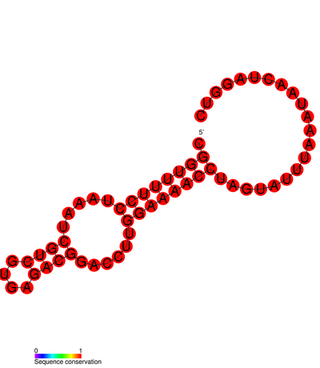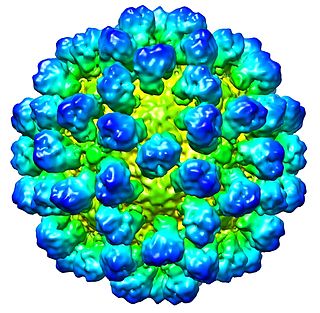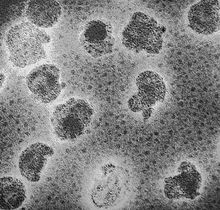
Podoviridae is a family of bacteriophage in the order Caudovirales often associated with T-7 like phages. There are 130 species in this family, assigned to 3 subfamilies and 52 genera. This family is characterized by having very short, noncontractile tails. Podoviradae are largely understudied and most new isolates are of the phicbkviruses genus, a group of giant viruses that appear to be Caulobacter specific.

Geminiviridae is a family of plant viruses that encode their genetic information on a circular genome of single-stranded (ss) DNA. There are 520 species in this family, assigned to 14 genera. Diseases associated with this family include: bright yellow mosaic, yellow mosaic, yellow mottle, leaf curling, stunting, streaks, reduced yields. They have single-stranded circular DNA genomes encoding genes that diverge in both directions from a virion strand origin of replication. According to the Baltimore classification they are considered class II viruses. It is the largest known family of single stranded DNA viruses.
Circoviridae is a family of DNA viruses. Birds and mammals serve as natural hosts. There are 101 species in this family, assigned to 2 genera. Diseases associated with this family include: PCV-2: postweaning multisystemic wasting syndrome; CAV: chicken infectious anemia.

Crinivirus, formerly the lettuce infectious yellows virus group, is a genus of viruses, in the family Closteroviridae. They are linear, single-stranded positive sense RNA viruses. There are 14 species in this genus. Diseases associated with this genus include: yellowing and necrosis, particularly affecting the phloem.

Tectiviridae is a family of viruses with 10 species in five genera. Bacteria serve as natural hosts. Tectiviruses have no head-tail structure, but are capable of producing tail-like tubes of ~ 60×10 nm upon adsorption or after chloroform treatment. The name is derived from Latin tectus.

Benyvirus is a genus of viruses, in the family Benyviridae. Plant serve as natural hosts. There are four species in this genus. Diseases associated with this genus include: BNYVV: rhizomania.

Corticovirus is a genus of viruses in the family Corticoviridae. Corticoviruses are bacteriophages; that is, their natural hosts are bacteria. The genus contains two species. The name is derived from Latin cortex, corticis. However, prophages closely related to PM2 are abundant in the genomes of aquatic bacteria, suggesting that the ecological importance of corticoviruses might be underestimated. Bacteriophage PM2 was first described in 1968 after isolation from seawater sampled from the coast of Chile.
Cheravirus is a genus of viruses in the order Picornavirales, in the family Secoviridae. Plants serve as natural hosts. There are five species in this genus.
Hordeivirus is a genus of viruses, in the family Virgaviridae. Plants serve as natural hosts. There are four species in this genus.
Pecluvirus is a genus of viruses, in the family Virgaviridae. Cereal crops and graminaceous weeds serve as natural hosts. There are two species in this genus. Diseases associated with this genus include: (SBWMV): green and yellow mosaic. The name of the genus is derived from Peanut clump virus: Peanut clump virus, giving rise to Pecluvirus.
Pomovirus is a genus of viruses, in the family Virgaviridae. Plants and dicotyledons serve as natural hosts. There are five species in this genus. Diseases associated with this genus include: dwarfing of shoots (mop-top) and potato spraing disease. The name of the genus is derived from Potato mop-top virus, Potato mop-top virus, giving rise to Pomovirus.
Sadwavirus is a genus of viruses in the order Picornavirales, in the family Secoviridae. Plants serve as natural hosts. There are three subgenera and five species in this genus. Diseases associated with this genus include: satsuma dwarf virus disease which causes spoon-shaped leaves on citrus tree. Symptoms are enations, multiple flushing, stunting or dwarfing, reduction in number and size of leaves and fruits. The name of this genus comes from one of its species: Satsuma dwarf virus.

Sobemovirus is a genus of viruses. Plants serve as natural hosts. There are 20 species in this genus. Diseases associated with this genus include: mosaics and mottles.
Tobravirus is a genus of viruses, in the family Virgaviridae. Plants serve as natural hosts. There are three species in this genus. Diseases associated with this genus include: SBWMV: green and yellow mosaic.
Endornaviridae is a family of viruses. Plants, fungi, and oomycetes serve as natural hosts. There are 31 species in this family, assigned to 2 genera. Members of Alphaendornavirus infect plants, fungi and the oomycete Phytophthora sp., members of Betaendornavirus infect ascomycete fungi.

Aspiviridae, formerly Ophioviridae, is a family of segmented negative-strand RNA viruses which infect plants. Member viruses are characterized by an elongated and highly filamentous and flexible nucleocapsid with helical symmetry. It is a monotypic taxon containing only one genus, Ophiovirus. Aspiviridae is also the only family in the order Serpentovirales, which in turn is the only order in the class Milneviricetes.

Lagovirus is a genus of viruses, in the family Caliciviridae. Lagomorphs serve as natural hosts. There are two species in this genus. Diseases associated with this genus include: necrotizing hepatitis leading to fatal hemorrhages.
Enquatrovirus is a genus of bacteriophages in the order Caudovirales, in the family Podoviridae. Bacteria serve as natural hosts. There is currently only one species in this genus: the type species Escherichia virus N4.

Ampullaviridae is a family of viruses that infect archaea of the genus Acidianus. Only one genus in this family has been described, Bottigliavirus, which contains three species. The name of the family and genus is derived from the Latin word for bottle, ampulla, due to the virions having the shape of a bottle. The family was first described during an investigation of the microbial flora of hot springs in Italy.
Plectrovirus is a genus of viruses, in the family Plectroviridae. Bacteria in the phylum Mycoplasmatota serve as natural hosts, making these viruses bacteriophages. Acholeplasma virus L51 is the only species in the genus.










